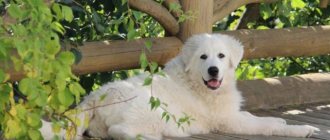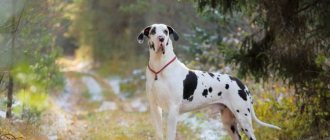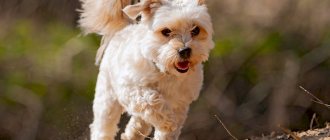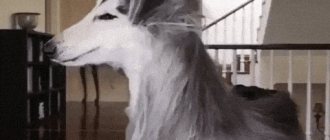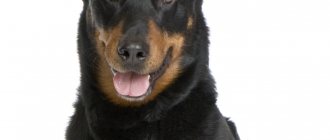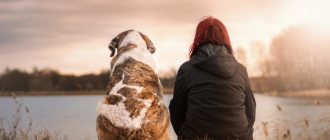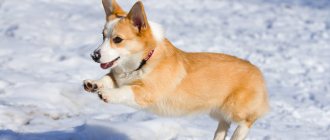The Bouvier des Flandres (French: Bouvier des Flandres Bouvier de Flandres) is a herding dog from Flanders, a region located primarily in Belgium, but affecting France and the Netherlands. The Bouvier des Flandres was used as a shepherd and cattle dog when driving livestock to markets. Before the outbreak of the First World War, the breed was little known, but after its end, it gained popularity as it took part in hostilities.
Origin
The name "Bouvier de Flandre" translated into Russian means bull dog. The first mention of these animals appeared in the 18th century in Flanders, whose territory today is occupied by France and Belgium. The Bouvier des Flandres was originally intended to guard domestic animals while grazing. This breed has the most intricate and mysterious history of appearance and development. Today you can hear more than ten assumptions about the origin of the Bouvier, but, unfortunately, none of them is supported by sufficient facts.
Until the eighteenth century, purebred representatives of the breed practically did not exist. The alternative is many different working dogs, which were crossed with each other to achieve the necessary working qualities. But everything changed with the creation of pedigree books and clubs, so, in 1890, original varieties of cattle dogs originally from Flanders began to be entered into the registers. The purpose of these animals was to protect and drive livestock to markets and pastures. They were indispensable assistants to shepherds, but at the same time completely unknown outside their homeland.
Interesting fact! Marie Louise Ramet (English novelist) published a book called The Dog of Flanders in 1872. It is believed that the main character, the dog Patrasche, was completely described as a Bouvier.
There are the following main theories of the appearance of the breed:
- the animals appeared as a result of crossing Dutch and German dogs;
- Bouvier De Flandres - descendants of Schnauzers (the most popular species at that time);
- the ancestors of the breed were French dogs that came to Flanders as a result of trade relations between different countries;
- the species appeared as a result of crossing different types of griffins with the Beauceron;
- the result of experiments carried out in a Flemish monastery. According to this theory, the monks crossed local shepherd dogs with wire-haired English species, for example, the Irish Wolfhound and the Scottish Deerhound.
Scientists believe that each hypothesis has the right to exist, because various European breeds could be used to obtain a universal shepherd. In 1890, representatives of this species deservedly received recognition, and in Belgium in 1914 the first standard was already written. During the First and Second World Wars, Bouvier de Flandres showed themselves to be brave and fearless fighters; they played an important role in the Belgian army. But such moments had a negative impact on the population of the species.
In the post-war period, former soldiers and pet owners continued the development of the species. America took a special part in restoring the population, where several dogs were exported in the early days of World War II. One of the most famous four-legged pets in the United States was the dog Lucky, whose owners were Nancy and Ronald Reagan.
Training, training
To train this dog, it is best to use the services of a professional dog trainer.
However, if you decide to raise your pet yourself, then you should remember a few rules for training these dogs. The Bouvier des Flandres needs the owner's firmness and confidence in his actions. The dog is easy to train, but can sometimes be stubborn. You must be persistent, patient and strict. Bouvier must understand who is boss. Otherwise it will be quite difficult with him. If the dog grows up in an urban environment, provide it with a lot of physical activity, as this is a working dog that needs mental and physical activity. The Bouvier des Flandres is a shepherd, which means it needs a lot of time in the fresh air. Bouvier is a wonderful friend who loves an active lifestyle in any weather. If you need a bodyguard or tracker, this dog would be a good choice. With him you will not be afraid for your children and yourself, because the Bouvier will always be able to protect both you and himself.
Appearance
Bouviers des Flanders are dogs with a very characteristic appearance, thanks to which they cannot be confused with other species. These are sophisticated, elegant and at the same time frightening animals. The exterior features of representatives of the breed are:
| Appearance | Characteristics |
| Dimensions | The height of Flemish cattle dogs at the withers ranges from 55 to 71 centimeters. The weight of the animals is 26-55 kilograms. |
| Head | Proportional to the body, massive. The transition from the muzzle to the forehead is moderate, but the presence of raised eyebrows makes it sharper. |
| Muzzle | Emphasized by a pronounced beard and mustache. Wide and massive, with strong bones. The cheeks are dry and flat. Large, round and black nose. |
| Jaw | Powerful jaw, equal length. The bite can be straight or scissor. Gums and lips are black. The teeth are white and strong. |
| Ears | Triangular standing and medium size. The seating position is high, the distance from each other is large. Traditionally docked. |
| Eyes | Oval in shape, set straight. Color – dark (walnut or brown). The look is wary, but at the same time direct and frank. |
| Body | The body is strong and muscular. The back is powerful and straight. The chest is deep. Neck with pronounced muscles. |
| Paws | The limbs are strong with well-developed muscles. The paws resemble those of a cat, the pads are hard and thick. The color of the claws is dark. The 5th toe on the front paws and the dewclaws on the hind paws must be removed. |
| Tail | It always stops at the age of one week after birth, leaving a maximum of two or three vertebrae. High rise. |
| Wool | The coat is hard and tousled, with a well-developed thick undercoat. The guard hair is rough to the touch, while the undercoat, on the contrary, is thin and soft. The length is average, shorter in certain areas of the body (ears, paws). Color can be represented by brown, gray, white, fawn, brindle. A white spot on the chest is acceptable. |
Cattle dogs from Belgium are compact, but at the same time powerful and hardy animals, which are distinguished by a strong bone structure, athletic muscles, a hard coat, and a stern and direct look. They are associated with incredible strength, lack of massiveness and roughness.
How to choose a pet
The Bouvier des Flandres is a rare breed, bred mainly by foreign nurseries. The average cost of a puppy is $500-600.
You can buy a dog cheaper, but there is a risk of becoming the owner of a non-purebred or sick animal. In order not to make a mistake in choosing a puppy, when buying a Bouvier des Flanders, it is recommended to pay attention to:
- presence of metrics and stamps;
- compliance with the breed standard;
- character traits;
- health status;
- conditions of detention.
A healthy Bouvier des Flandres puppy has straight limbs, clean ears, a soft belly, clear shiny eyes, coarse wavy hair, a short muzzle and a well-fed body. It is important that the baby does not have signs of rickets and parasitic infestations.
Breed Features
Representatives of this breed are distinguished by their balance, devotion to their owners and obedience. They choose one person from all the household members who is more listened to and respected, but who is loyal to all family members. Bouviers des Flandres are calm, but they may prefer active games or, conversely, move less.
With proper upbringing, they become ideal partners, good-natured home owners and brave defenders. At home they are practically invisible, but in the ring and for walks they demonstrate all their skills. Representatives of the species take personal responsibilities with great responsibility, but do not like to do something against their own will. They feel confident around the owner.
Such animals are characterized by an inquisitive and good-natured character. But in the learning process they need a firm hand without severity and aggression. These stubborn dogs love to play and fool around, and even adults have such traits.
The main purpose
During the First World War, these dogs proved to be excellent bodyguards, so they were subsequently kept in this capacity. As a result, the French Bouvier developed a rather strong protective instinct. They are quite wary of strangers, since Bouviers have suspicion of them in their blood.
This dog does not show aggression, it tries to protect, and if raised correctly, it will behave quite politely. Manifestations of aggression can begin in the absence of socialization, which is very important for Bouviers.
These sensitive dogs make excellent watchdogs - they protect their territory with a loud and frightening bark. The Bouvier des Flandres is always ready to protect his people from any danger. In the process of defense, dogs never immediately rush to attack; they try to scare the enemy by barking and threatening poses. But if there is a need to use force, then they will not think for long and will attack, no matter who their opponent is.
They have a very touching attitude towards children, especially those who have grown up before their eyes, and can become best friends. But the dog is very wary of unfamiliar children and its behavior is difficult to predict. The natural dominance of these dogs does not allow them to behave friendly with other animals in the house and, in particular, with dogs. Bouviers of both sexes exhibit particularly strong same-sex aggression.
Breed standard
| Standard No. – 191. The International Canine Federation approved standardization: October 25, 2000. Name: Bouvier de Flanders, Bouvier de Flandres, Flanders cattle dog. Country of origin: France, Belgium. | IFF classifier:
|
Where to buy a Bouvier des Flanders puppy
Puppies can be purchased from specialized nurseries. To get an idea of the price for this breed, just go to the bulletin board.
Bouvier des Flandres kennels
In St. Petersburg, the Bouvier des Flandres is sold in the Volchya Zemlya kennel, where breeding work is carried out, in the Tambov region - the professional cynological kennel "Hit Alivet", in Moscow and the Moscow region - kennels "S Cherry Orchards", "Kennel Family Flight" , “Apple of the Eye”, “Royal-Puppy”, as well as a number of others.
Nutrition
Bouvier de Flandres can be fed with premium industrial dry food and natural food. A natural diet must include:
- lean meat;
- offal;
- dairy products;
- sea fish fillet;
- vegetables;
- fruits;
- porridge (buckwheat, rice, oatmeal).
It is prohibited to feed Flemish cattle dogs:
- sweets;
- smoked meats;
- pickled products;
- sausages and sausages;
- potatoes;
- canned food;
- chicken bones;
- seasonings
Premium dry dog food
Rating
Holistic dog food
Rating
Small breed dog food
Rating
Dry food consists of the required amount of vitamins and microelements, proteins, fats and carbohydrates. This composition will saturate the four-legged pet’s body with all the important components for proper development.
Mating
In a litter, Bouvier des Flandres bitches give birth to 6 to 9 puppies. Pregnancy lasts from 63 to 72 days. Signs appear in the third week. On days 21–22, small hard round lumps can be detected on both sides of the dog’s abdomen using your fingers, which can be palpated until day 35. With the onset of the fifth week, the bitch’s mammary glands enlarge, and in the sixth week, the belly enlarges. A few days before giving birth, it goes down.
A pregnant dog needs a lot of protein. During the first month, the bitch is fed as usual. Further, her diet is based on meat, dairy products, eggs, and fish. The amount of food is doubled.
Important! The bitch should not be overfed. If she gains excess weight, it will complicate the birth process. When feeding with industrial formulas, switch the bitch to a special formula for pregnant women.
In the first half of pregnancy, there is no need to change your walking routine. Then, as the belly increases, the dog itself will refuse to walk for a long time. The bitch should not go up and down stairs or make sudden movements. Don't let her sit on a cold floor.
You need to take care of the place for childbirth in advance. Prepare for this purpose a box corresponding to the size of the dog, a puppy box, diapers, a heating pad, thread, scissors, and disinfectant.
With the onset of the last days of pregnancy, do not leave the bitch unattended. Before birth approaches, she becomes restless, whines, scratches the floor, tears up the bedding, refuses food, and spins around in one place. The dog's body temperature drops to 36.5–37 °C. She begins to have mucous discharge. At the same time, the bitch takes a lying position, presses her back against the box and rests her paws against the wall.
The first puppy is often the largest, so its birth is more difficult than the birth of other cubs. They usually come out with their heads forward and their backs up. The puppy appears in the amniotic sac, which needs to be torn. Then you should remove the baby and cut the umbilical cord at a distance of 2-3 cm. But if the dog wants to do this on its own, there is no need to interfere with it.
If bleeding occurs, tie the umbilical cord with a thread. Wipe the puppy with a napkin and place it next to the bitch. She will begin to lick the baby, which will help stimulate his blood circulation and breathing. After the puppy is born, the placenta is expelled. If the afterbirth does not come out, you must contact a veterinarian, otherwise the dog will die. The bitch also requires medical attention if the interval between the birth of puppies exceeds 2 hours.
Frequent problems and illnesses
The most common diseases of Bouvier des Flandres include:
- dysplasia of the hip and elbow joints;
- glaucoma;
- heart failure;
- diseases associated with the thyroid gland.
This breed of dog is one of those species in which the fewest hereditary diseases have been found. In addition to good health and an original exterior, the animals are distinguished by their impeccable service capabilities (pathfinders, watchmen and protectors). The Bouvier des Flandres is a Belgian bear with an ideal character who enjoys playing with children and is devoted to his household.
Dogs can recognize human emotions
Dogs are the only animal species, other than humans themselves, that can recognize our emotions. A quick glance is enough for them to understand whether you are happy, embarrassed, angry or sad. They are even able to empathize with people, feeling the same emotions as their person.
A dog is the first animal to orbit the Earth
Laika became the first living creature to orbit the Earth. Her flight on Sputnik 2 took place in 1957. Although she herself died during the flight, her daughter, Pushinka, gave birth to 4 puppies from the terrier Charlie, whose owner was US President John F. Kennedy.
Having a dog in the house can protect owners from asthma and colds
Research shows that children who lived in households with dogs had fewer allergies and were less likely to get sick than children who were raised in households without pets.
Dossier
Adult height: 60-68 cm. Weight: 30-40 kg. Characteristic color: black, gray, brown, brindle, “salt and pepper” (spotted color and too light are considered a defect). Coat length: medium length, hard with undercoat. Life expectancy: up to 12 years. Advantages of the breed: intelligent, agile, adapted to bad weather, healthy Difficulties of the breed: stubborn character, there is a predisposition to hip dysplasia. Average price: from $1000 to $2000. Classification: large breed, herding, guard.
Pet care
Apartment rules
Bouviers need intense exercise if they live in an apartment.
The most suitable place for a Bouvier is to live in a private house, but if the owner is willing to provide the pet with sufficient exercise, the dog can be kept in an apartment. Do not forget that this is a working breed. A sedentary lifestyle negatively affects the character of the Bouvier des Flanders, which is reflected in damage to interior items and shoes.
From six months, the dog should run at least 3–4 km daily. The minimum duration of one walk is 30–40 minutes. You need to take your Bouvier outside 3 times daily. Organize a relaxation area for your pet in your apartment. To do this, choose a secluded place away from the passage, heaters and air conditioners, and lay out a mattress for the dog that matches its size.
Key features of hygiene and trimming
The Bouvier's thick coat requires regular trimming.
Brush your pet at least 2 times a week, but it is better to do it daily. To do this, use a slicker brush and a metal comb. You should not bathe your animal often. Once a month is enough. Particular attention should be paid to the haircut. It is advisable to regularly shorten the hair on the lower part of the paws between the toes, on the stomach, under the tail, on both sides of the ears, and on the tail. The covering in the forehead area (up to the occipital protuberance), as well as on the cheekbones (up to the beard line) should be plucked. Thanks to this procedure, the animal's head acquires a square shape. The fur between the eyes is not trimmed, it must be combed over the face.
Important! You cannot shorten the coat too much, as this will disrupt the natural appearance of the Bouvier. It is best to entrust the procedure to a specialist.
If hair gets into the eyes, it can cause inflammation and suppuration. Therefore, you should examine your dog daily. Remove discharge from the eyes with a napkin soaked in weak tea leaves. Once a week, inspect and clean your pet's ears with a damp cotton pad. Monitor the condition of the claws. To prevent your dog from experiencing discomfort, trim them at least once a month. Every week, pay attention to the hygiene of your pet’s teeth, clean them with a special paste and brush.
Important! After feeding, wipe your dog's mustache and beard.
The nuances of proper dog nutrition
The Bouvier's diet should be as balanced as possible
Bouviers are undemanding when it comes to diet. They can be given industrial mixtures or natural products. The dog is fed beef, poultry, sea fish, cereals, vegetables, kefir, and cottage cheese. Boiled eggs are given twice a week. Water must be in unlimited access. You can determine the required amount of food based on your pet’s weight. Young animals under 12 months of age should receive 40 g per 1 kg of body weight per day. After a year, the norm should be reduced by 2 times.
A puppy up to 6 months is fed three times a day. In the future, food is given 2 times a day. Some owners switch adult dogs to single meals. If you prefer to feed your pet special mixtures, choose high-quality premium products: ACANA, Artemis, CANIDAE, Almo Nature, 1st Choice, Happy Dog. These formulations are made on the basis of natural products without the use of artificial ingredients.
French Griffons
In addition to smooth-haired dogs, a group of hounds with hard, shaggy hair—griffons—were bred in France. These are medium or large dogs, good hunters, faithful companions.
5 French Griffons have received international recognition:
- Vendée. Hardy, energetic hunter. Friendly, sociable companion. The FCI divided Vendean Griffons into 2 breeds based on size: medium - up to 55 cm in height and large - up to 68 cm.
Large Vendean Griffon.
- Blue Gascony. A wire-haired type of Gascony hound. Height at withers up to 58 cm.
Gascony Griffons have thick mustaches and goatees.
- Niverneysky. Griffon is medium-sized up to 62 cm at the withers. In his homeland he received the nickname “dirty”: due to the darkening at the tips, the fur seems dirty.
- Red Breton. An energetic dog with a height of 47 - 58 cm. In France, they are often kept as pets. Despite the developed hunting instinct, the Breton Griffon makes a vigilant watchdog.
French Basset Hounds
Short-legged puppies were sometimes born in litters of standard hounds. The breeders kept them and adapted them for hunting on foot, searching for and pursuing a wounded animal. Low dogs with short limbs deftly made their way through thickets of bushes, where large and medium-sized dogs could not get through.
In France, 5 basset dogs were bred, which were named after the place of breeding and color:
- Artesian-Norman. Tricolor small smooth-haired dogs 26 – 36 cm tall. Nowadays they are more often kept as companions.
- Small and large Vendean Basset Griffon. Two wire-haired breeds with separate standards. The height of the large “Vendeen” is 39 – 44 cm, the small one is 34 – 38 cm.
Small Vendean Basset Griffon.
- Blue Gascony. The smallest representative of the blue Gascony hounds. An agile, diligent hunter with a keen sense of smell. Affectionate, friendly companion. The height of the Gascony Basset is 34 – 38 cm.
- Fawn Breton Basset Griffon. An energetic, determined dog with a height of 32 – 38 cm. A passionate hunter, a cheerful, sociable companion.
Griffon Korthals
A wirehaired pointer, the founder of which was the passionate hunter and breeder Eduard Kortal. He devoted his whole life to breeding the ideal griffon - a universal hunter, a faithful companion.
As a result of selection, a hardy, strong pointer up to 60 cm at the withers was obtained. The body is covered with coarse fur, and the face has a beard, mustache and eyebrows. Color – gray with a steel tint, brown spots. Korthals griffons cannot live in enclosures. They suffer from long periods of loneliness and feel better in a home with their owner’s family.
French water dog barbet
The oldest hunting dogs in France. Presumably they participated in the development of other French breeds - poodles, bichon frize. It is no coincidence that the Barbet looks like an uncut large poodle.
Photo from a book about barbets.
The height of the barbette is 55 – 65 cm. The wool is hard, elastic, curly. The length depends on the climate - the colder it is, the longer and thicker the coat. Solid or mixed colors - gray, coffee, black, fawn, white, chestnut.
Barbets are known as hyperactive, playful, noisy pets. However, they are easy to train, do not have conflicts, and are friends with children.
Historical reference
The Bouvier des Flandres dog is a working, herding dog that was not intentionally bred. On farms there is always a place for large four-legged animals performing security and court service. With the development of cattle breeding, the Bouvier of Flanders began to be actively used for grazing cattle and sheep.
The homeland of the breed is the territory of Belgium and France (formerly Flanders), with a climate suitable for raising livestock. However, in spacious meadows, where there is no protection from precipitation and wind, the working conditions are quite harsh. The Flanders Bouvier has evolved to keep up with the demands of farmers. The dog's coat became tougher, the undercoat was denser, even the beard and mustache served for protection. By the way, thanks to the rich vegetation on the face, one of the popular names for four-legged animals sounds like “dirty beard.”
This is interesting! The Bouvier of Flanders was actively used for some time to move cargo, but unlike draft dogs, the four-legged dogs carried luggage in baskets.
Despite the main version of the history of the breed, that the Bouvier of Flanders is an aborigine, there is a document stating that the four-legged animals were bred using selective breeding. In the 50s of the 20th century, a report was published containing evidence that representatives of the breed had lived in monasteries since the 12th century and were subject to deliberate selection. According to this version, the Bouvier of Flanders is not an indigenous breed, but a deliberately bred one . Dogs imported from England became the basis for breeding work.
This is interesting! The Flanders Bouvier, despite its rustic appearance, is actively used for work in the police and intelligence services.
The Bouvier des Flandres is a very hardy dog and has been used to its full potential . One or more four-legged animals lived on the farm, grazed, guarded, helped transport goods, and were busy working up to 18 hours a day. With the development of market (literally) trade, Bouviers of Flanders began to be used for transporting carcasses on carts.
Early individuals were noticeably different from modern dogs, with a great contrast in appearance. Modern representatives of the breed require a certain amount of care and grooming, while early dogs looked more like shaggy giants. Despite their power, the gene pool of the quadrupeds was built on the blood of greyhound dogs , distinguished by strength but refinement. Already at the end of the 20th century, strictly selective selection was carried out. Experts sought to preserve the working qualities of the breed, but give it a more pleasant appearance. The first participants in breeding work were distinguished by their strength, coarse wool, hunting and guarding skills. At the second stage, after obtaining an acceptable exterior, aboriginal Flanders Bouviers were included in the breeding work. Thus, an almost universal herding breed was obtained.
As mentioned above, Bouviers of Flanders were used for cargo transportation. The dog pulled a small cart itself, but there are confirmed facts that representatives of the breed also worked as sleds. For a relatively short time, the rock was also used to work in mills. The dogs were harnessed to millstones that spun in a circle. The four-legged animals walked in harness for 5–6 hours.
Despite a number of hypotheses put forward, official data indicate that before the 20th century, breeding of the breed took place mainly chaotically. However, official sources do not deny that individual bloodlines could be amenable to selection.
This is interesting! During the war and post-war years, the Flanders Bouviers were on the verge of extinction.
The breed standard for the Flanders Bouvier was developed in 1912 and a year later officially adopted in its homeland (the breed is now under the patronage of France). The international standard breed description was approved in 1937. Disputes over the fairness of the requirements and proposals to revise the standard remained relevant until the 50s. It took experts about 10 years to resolve all controversial issues. By 1965, a unified breed standard was adopted.
